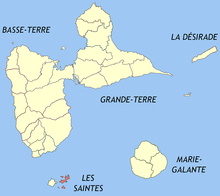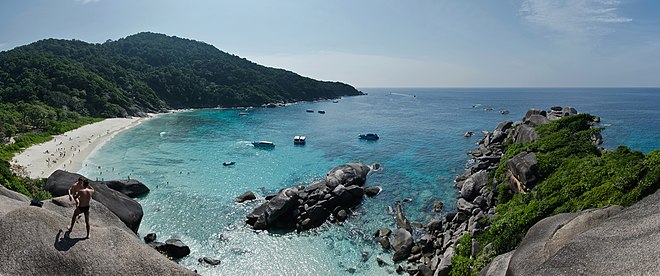Terre-de-Haut Island
Terre-de-Haut Island (officially in French :Terre-de-Haut des Saintes (literally: highland of les Saintes)) is an island in the Îles des Saintesarchipelago, in the Lesser Antilles. It belongs to the commune (municipality) of Terre-de-Haut into the French department of Guadeloupe. The bay ofTerre-de-Haut is one of the most beautiful bay of the world including the club of the most beautiful bay of the world in 2001.
 Terre-de-Haut view from Chameau hill. | |
 | |
| Geography | |
|---|---|
| Location | Caribbean sea |
| Coordinates | 15°52′N 61°34′WCoordinates: 15°52′N 61°34′W |
| Archipelago | Îles des Saintes |
| Total islands | 9 |
| Major islands | Terre-de-Bas Island |
| Area | 5.2 km2 (2.01 sq mi) |
| Highest elevation | 306 m (1,004 ft) |
| Highest point | Chameau hill |
| Country | |
| France | |
| Overseas department | Guadeloupe |
| Canton | les Saintes |
| commune | Terre-de-Haut |
| Largest city | Fond-du-Curé |
| Mayor | Louis Molinié |
| Demographics | |
| Population | 1838 (as of 2006 census) |
| Density | 352 /km2 (912 /sq mi) |
Geography
[edit]Description
Terre-de-Haut island is the most easterly island of the archipelago of les Saintes. Like its neighbour Terre-de-Bas, it holds its name from the maritime vocabulary which called the islands exposed to the wind hightland and those protected from the wind, lowlands. It is an island of 5.2 km2(2.0 sq mi) dominated in the North by Morne Mire hill (107 metres (351 ft)) and Morel hill (136 metres (446 ft)) and in the South by Chameau hill 306 metres (1,004 ft), the highest mount of the island and the entire archipelago. Terre-de-Haut is separated from Terre-de-Bas by a narrow channel of 890 m (0.55 mi). Besides Terre-de-Bas, several small islands surround Terre-de-Haut :
A remarkable peninsula called Pain de sucre (Sugar loaf) with the height of (53 metres (174 ft)) is linked to Terre-de-Haut by an isthmus.
Populated areas
Small villages are seen spread out in the rolling hills in the interior. Fond-du-Curé, the most important village of the island is located in a natural harbour. Yachts and cruise boats are a common sight in the harbour. The oldest settlements still remaining are the villages of Mouillage and Fond-du curé.[2] The population is spread among 20 quartiers (districts), more or less well delimited. They are grouped into two halves:[3]
| Au vent (Windward) | Sous le Vent (Leeward) | ||
|---|---|---|---|
| Nr | Quartier | Nr | Quartier |
| 1 2 3 4 5 6 7 8 9 10 | Pompierre Marigot Vieille-Anse Fort Napoléon Maison blanche la Coulée Coquelet Anse-Mire Mouillage Grande-Anse | 11 12 13 14 15 16 17 18 19 20 | Fond-du-Curé la Savane Anse Rodrigue Anse Galet Prés Cassin la Convalescence Anse Figuier Pain de sucre Anse à Cointe Anse Crawen |
The local vocabulary says: "to go up" to move towards the windward quartier (to Fort Napoléon) and "to go down" to move towards the leeward quartier (to Pain-de-sucre).
Demography
The inhospitable relief and the low precipitation do not allow the establishment of agriculture. Few slaves were brought onto these islands. The population is constituted historically by Bretons, Normans and by inhabitants of Poitou who settled down to fish. This explains the European type of the people from les Saintes (Saintois) French: [sɛtwa] ( listen) (French gentilic of the inhabitants of les Saintes).
listen) (French gentilic of the inhabitants of les Saintes).
In 2006 the population of Terre-de-Haut is established like this:
1,838 inhabitants was the average between 1999 and 2006, with a density of population of 306 inhabitants / km2. The number of households is 693.[4]
[edit]Climate
Main article: Climate of les Saintes
[edit]Language
Main article: Language of les Saintes
[edit]History
Main article: History of les Saintes
[edit]Culture
Main article: Culture of les Saintes
[edit]Economy
Main article: Economy of les Saintes
The island lives essentially on fishing and tourism. Its fishermen are recognized[by whom?] through the Caribbean islands as being among the best.
The island contains a UCPA center which account 60 bungalow, and approximately 120 trainees every week. it closes only two months in the year because of the weather conditions.
[edit]Environment
Main article: Environment of les Saintes
[edit]Transport
Main article: Transport in les Saintes
[edit]To see
- The bay of les Saintes (the second most beautiful bay of the world)
- The museum and the botanical garden of Napoleon fort
- The natural reserves of Chameau and "Morel" hill.
- "Caroline Artillery battery" (Morel hill) and "Modele Tower" (Chameau hill)
- The French navy cemetery of Terre-de-Haut
- The lighthouse of the Port of Terre-de-Haut.
- The "Bateau des îles" or the house in the shape of bow of ship
- The chapel of the Calvary
- The square of the Governor Lion or square of the port, with its colored houses.
- The organs pipes of basalt of Pain de sucre
- Notre Dame de l'Assomption's church
- The diving sites
- The multiple beaches (Anse Crawen, Pompierre, Anse Rodrigue, Anse Figuier, Marigot beach, Anse Mire, Grande-Anse, Vieille Anse , Anse à Cointre, Pain de Sucre Etc.)
Similan Islands
The Similan Islands (Thai: หมู่เกาะสิมิลัน, Thai pronunciation: [mùː kɔ̀ʔ si.mi.lan], Malay: Pulau Sembilan سمبيلن ڤولاو) is a group of islands in the Andaman Sea off the coast of, and part of, Phang Nga Province, southern Thailand. It is anational park which was established in 1982.Similan Islands National Park was established after a one-year exploration by the forestry department. The park is anarchipelago consisting of nine islands named Ko Bon, Ko Bayu, Ko Similan, Ko Payu, Ko Miang (two adjoining islands), Ko Payan, Ko Payang, and Ko Huyong. Recently, the park was expanded to included two remote islands named Ko Bon and Ko Tachai. The Similans are situated 70 kilometres from Phang Nga town. "Similan" is a Yawi word which means "nine". Similan is one of the most famous diving sites in Thailand, and noted as one of the top ten dive destinations in the world according to the National Geographic Society.It is located at 8°39′09″N 97°38′27″EAttractions
[edit]Koh Similan
Koh Similan is the largest island. There are a total of 9 islands. The sea in the area has an average depth of 60 feet. Underwater it is full of rock formations and coral reefs in several shapes and forms, resembling such things as deer, leaves, brains, and mushrooms.Above the water are found many diverse species such as the Nicobar Pigeon, Mangrove Monitor Lizards and more.[edit]Koh Huyong
Koh Huyong has the longest and widest beach in the park. However, the park prohibits any tourists from landing on the island as the beach is a place where turtles come to lay their eggs.[edit]Dive sites
The Similan national park is famous for its dive sites. It has typically two different kinds of diving. East side diving consists of gently sloping coral reefs with sandy patches and the occasional boulder in between. The west side is known for its huge underwater granite boulders with numerous swimthroughs. Maybe the most famous east side dive site is East of Eden, off Island number 7. Elephant head rock is arguably the most famous west side dive site with a maze of swimthroughs and the reputation for spin-cycle like currents running in every direction.Elephant head rock was named by Horst Hinrichs from Germany in the mid 70s, founder of one of the oldest dive shops in Phuket, Santana Diving.Other popular dive sites include North Point, Deep Six, Boulder City and the awesome pinnacles off Koh Bon and Koh Tachai.The most important of all dive sites in the Similans, which is actually part of Surin National Park, is Richelieu Rock, famous for its incomparable variety and abundance of marine life. Whale shark sightings are not uncommon here.However, since 1999, its once most beautiful dive site, the Fantasy Reef, has been closed from all diving activities after its condition had significantly deteriorated. Park chiefs officially blame diving for the deterioration, while dive operators in the area claim that fishing boats, with or without permission, enter the national park during low season, when no dive operators are allowed in the national park.[citation needed] The national park also claims that the dive site suffered significant damage from the tsunami in 2004, and continues to keep the reef closed. Since noone but the national park staff is allowed to dive Fantasy Reef it has been impossible to confirm that statement.[edit]Wildlife protection
Islands 1, 2 and 3 are closed for public due to turtle hatching protection program and reef conservation efforts. Island number 3 belongs to HM the Thai Princess. Fishing is banned in Similan and Surin National Park, however fishing boats are constantly seen in and around the Park. When diving, one can often find nets stuck to reefs and illegal fishing traps. Park rangers are posted on several islands but seem to be little interested in anything beyond collecting the national park fees, which have to be paid in cash. Consequently corruption is rife. Mid November 2007 the Rangers increased the Surin national park fee to 600bt per person from 400bt with no prior announcement and posted a patrol boat at Richelieu Rock to collect the fees.This season many illegal fishing traps have been found outside the most common dive sites, suggesting the fishermen are betting on divers not venturing off the known dive sites. They have contained among others Giant Trevallies, Batfish, Barracudas, Golden Pilot Jacks, Giant Triggerfish etc.The fishing traps seem to be overly abundant around Koh Bon and Koh Ta Chai.Public awareness of this increasing problem will be the only way to change the situation so if you visit Similan and Surin National Parks and witness illegal fishing, please report your sightings. Public pressure and fear of lost revenue will eventually force the authorities to lean on the Rangers to actually do what they are supposed to do - protect the most beautiful and famous island group and dive sites in ThailandThe area has deteriorated to the point that the most famous dive sites are mostly broken and dead coral with few reef fish.[edit]Access
Access to the Similan Islands is easiest from Khao Lak, Phang Nga province. The mainland office is in Thap Lamu. Boats depart daily from November-May. The trip takes three hours each way on slow boats or 70 minutes via speedboat.During the months November-May also live-aboard boats head to the Similan Islands. These dive boats depart and return from Khao Lak, Ko Lanta, Phuket and Ranong and stay for several days at the Similan National Marine Park.






